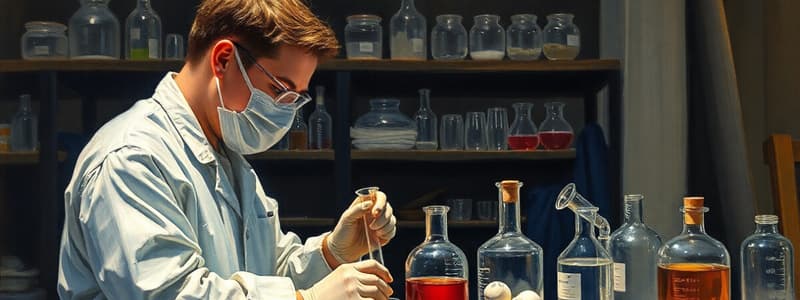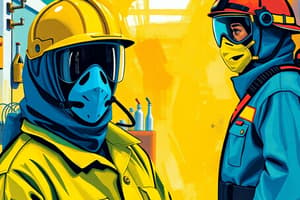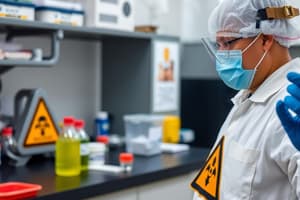Podcast
Questions and Answers
Which of the following is NOT a safety equipment used in the school laboratory?
Which of the following is NOT a safety equipment used in the school laboratory?
- Laboratory coat
- Sand bucket
- Fume cupboard
- Heat-proof mat (correct)
Using an eyewash bottle is the recommended action if chemicals get into our eyes.
Using an eyewash bottle is the recommended action if chemicals get into our eyes.
True (A)
What should you do if you encounter a fire in the laboratory?
What should you do if you encounter a fire in the laboratory?
Use a fire extinguisher or fire blanket.
A ______ is used to protect your eyes while working in the laboratory.
A ______ is used to protect your eyes while working in the laboratory.
Match the following safety equipment with their purposes:
Match the following safety equipment with their purposes:
What should you do before heating or mixing substances in the lab?
What should you do before heating or mixing substances in the lab?
You can throw solid wastes into the sink in the laboratory.
You can throw solid wastes into the sink in the laboratory.
What should you do immediately after an accident in the lab?
What should you do immediately after an accident in the lab?
The three conditions in a fire triangle are fuel, heat, and ______.
The three conditions in a fire triangle are fuel, heat, and ______.
Match the hazard symbols with their meanings:
Match the hazard symbols with their meanings:
What is the primary function of a gas jar?
What is the primary function of a gas jar?
A conical flask is primarily used to collect gases.
A conical flask is primarily used to collect gases.
What is the purpose of a boiling tube?
What is the purpose of a boiling tube?
The ______ is used to store liquids that will be used in drops.
The ______ is used to store liquids that will be used in drops.
Match the following laboratory apparatus with their functions:
Match the following laboratory apparatus with their functions:
What is the primary function of a dropper?
What is the primary function of a dropper?
A spatula is used to hold hot objects.
A spatula is used to hold hot objects.
What apparatus is used to separate solids from liquids during filtration?
What apparatus is used to separate solids from liquids during filtration?
The __________ is used to fix the positions of various apparatus in a laboratory.
The __________ is used to fix the positions of various apparatus in a laboratory.
Match the following laboratory apparatus with their functions:
Match the following laboratory apparatus with their functions:
What is the purpose of drawing vertical section diagrams of the apparatus?
What is the purpose of drawing vertical section diagrams of the apparatus?
Vertical section diagrams are useful for documenting laboratory experiments.
Vertical section diagrams are useful for documenting laboratory experiments.
What do vertical section diagrams help illustrate in a laboratory setting?
What do vertical section diagrams help illustrate in a laboratory setting?
Vertical section diagrams of the apparatus are drawn to show the __________.
Vertical section diagrams of the apparatus are drawn to show the __________.
Match the following terms with their descriptions:
Match the following terms with their descriptions:
Flashcards are hidden until you start studying
Study Notes
Laboratory Safety Equipment
-
Laboratory coat, safety goggles, protective gloves, fire blanket, fire extinguisher, sand bucket, eye wash bottle, and first-aid box are crucial safety equipment in a laboratory.
-
A fume cupboard is a ventilated enclosure for handling hazardous chemicals and vapors.
Laboratory Safety Rules
- Do not eat or drink in the laboratory.
- Always wear safety goggles when heating or mixing substances.
- Tie up long hair and tuck in school ties when doing experiments.
- Never smell or taste any chemicals unless instructed by your teacher.
- Avoid pointing test tubes containing boiling liquids towards yourself or other students.
- Report all accidents to your teacher immediately.
- Do not throw solid wastes into the sink.
Hazard Warning Symbols
- Hazard warning symbols alert us to the potential dangers of hazardous chemicals.
- U (Corrosive), V (Harmful), W (Explosive), X (Toxic), Y (Flammable), and Z (Irritant) are common hazard symbols to be aware of.
Fire Triangle
- Fuel, water, and high temperature are essential components for a fire to start.
Laboratory Apparatus
-
Gas jar, dropping bottle, watch glass, evaporating dish, measuring cylinder, boiling tube, test tube, beaker, conical flask, and reagent bottle are commonly used to hold substances in the laboratory.
-
Glass rod, spatula, filter paper, test tube holder, test tube rack, tongs, stand and clamp, dropper, and funnel are various tools used for different purposes in a laboratory.
-
Bunsen burner, wire gauze, tripod, and heat-proof mat are essential apparatus for heating substances in a laboratory.
Studying That Suits You
Use AI to generate personalized quizzes and flashcards to suit your learning preferences.



